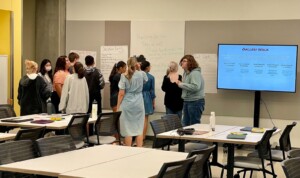Leading Online and Offline: New Book Offers 6 Tips for EdLeaders

Some books offer theoretical frameworks, others offer practical advice. Blending Leadership, the new book from Stephen Valentine and Reshan Richards, is the latter–a quick, story filled, illustrated set of six suggestions for school leaders.
The Google education team has been thinking about EdTech leadership; they’d like to see less textbook replacement and encourage more transformational learning. Evangelist Jaime Casap said he’s been looking for resources they can point school leaders to as they dive deeper into understanding what it takes. He saw Blended Leadership and liked the leadership focus, “not just apps but the systems they should be using to run their organizations.”
“Leaders define reality.” Blending Leadership opens with a Max De Pree quote (from the best leadership book of all times, Leadership is an Art). The authors go on to describe how leaders help build belief systems grounded in a shared reality.

Next, “Leaders have a responsibility to be aware of choices,” said Richards. The book attempts, according to Richards, to uncover unquestioned beliefs, to challenge practices and to serve as a catalyst for student-centered change.
The following is a quick spin through the book with a comment on each of the six leadership beliefs. 
1: Blended Leaders Engage with Thought Leaders and Engage as Thought Leaders. Reshan suggests connecting with people thinking about the future of education as “they’re totally accessible.”
The authors encourage EdLeaders to get out of the building. (We think school visits are the best form of professional learning).
“By telling stories and articulating what’s happening in your own institutions, you are contributing to a thought leadership conversation,” added Reshan
2. Blended Leaders Design Spaces and Care for Spaces. Steve says physical spaces should match intention.
Reshan recounts a story of students building furniture and setting up a classroom–a successful experiment in student ownership and a lesson in space design.
The authors urge care for online spaces as well as physical spaces. Thoughtful combinations of pedagogy, space and technology can support active learning. (Here’s what active learning looks like in El Paso.)
3: Blended Leaders Reject Insularity and Embrace Sharing. Richards said it’s time to “open the doors, create opportunities for serendipity and stumble onto something useful.” The authors suggest sharing student work on blogs and Twitter.
“Blended leaders favor opening their iterative process, their inquiry, to others,” said the authors. They encourage disruption, but doing so with humility.
They describe moving from small to large working groups and finally to community conversations. “Blended leaders are interested in using technology to scale organizational learning.”
4. Blended Leaders Challenge Meeting Structures and Change Meeting Structures. Leaders help communities save time and share talents. Reshan says start by getting rid of bad meetings. Steve says start by re-examining the school calendar, which is usually more about tradition than kids.
5. Blended Leaders Articulate a Mission and Advance a Mission. Richards stressed connecting personal belief structures and institutional mission. They note that EdLeaders are “Storytellers-in-Chief.” The chapter gets practical quick–including a discussion of why Slack and Twitter are so useful.
The transformation process only works if everyone knows about the mission and articulates in ways in which constituents are likely to see and understand it.
6. Blended Leaders Keep the Off-Ramp Open and Use It Frequently. Leaders nurture the offline as well as the online world. Reshan said, “It’s important to put the screen down and refocus–it’s people first, not the technology.” He added, “It may be time to skip the email and do a walking meeting.”
Not quick to adopt acronym models, the authors think SAMR is a useful frame.
Good leaders “pull signals from the noise.” The authors observe that leaders tell stories; they are brave and resilient, they organize people around a common purpose. They keep their eye on priorities and push their teams.
Blended Authors
Steve Valentine is the assistant head of the upper school at Montclair Kimberley Academy in New Jersey. His blog is Refreshing Wednesdays
Valentine’s co-author and former teaching colleague, Reshan Richards, is also the chief learning officer and co-founder of Explain Everything and an adjunct assistant professor at Teachers College, Columbia University. His blog is Constructivist Toolkit.
The book originated as a conference presentation in an effort to show people some of the choices they have, said Valentine. Brad Ovenell-Carter created sketch notes at the conference and the authors liked them so much they asked him to illustrate the book.
Each chapter includes a recap with offline, online and blended suggestions. Check it out.
For more see:
- 6 Practices of Thoughtful Leaders
- Agreement Crafting: 10 Lessons on The Politics of Schooling
- 5 Lessons on Impact Leadership
Stay in-the-know with all things EdTech and innovations in learning by signing up to receive the weekly Smart Update.



0 Comments
Leave a Comment
Your email address will not be published. All fields are required.